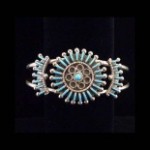 The third technique, needle point, requires the highest level of skill to achieve success. Like the other Zuni jewlery techniques, petit point and snake eye, needle point has been made possible by finer tools that allow for extremely delicate stone carving. Needle point requires thinly sliced cabochons with finely polished and finely pointed ends. The very nature of the shape, as well as the number of cuts necessary to achieve the correct shape, requires a great amount of patience and skill. Artists that are new to needle point can expect to create 10% usable cabochons. The remaining 90% will be shattered and broken pieces. These small broken fragments are usually too small to be reused and are used for purposes other than jewelry (example: for turquoise fill used in pottery, or turquoise pigment for dyes and paints). Once the artist gains experience, the waste pile shrinks and the cost to create each usable cabochon shrinks as well.
The third technique, needle point, requires the highest level of skill to achieve success. Like the other Zuni jewlery techniques, petit point and snake eye, needle point has been made possible by finer tools that allow for extremely delicate stone carving. Needle point requires thinly sliced cabochons with finely polished and finely pointed ends. The very nature of the shape, as well as the number of cuts necessary to achieve the correct shape, requires a great amount of patience and skill. Artists that are new to needle point can expect to create 10% usable cabochons. The remaining 90% will be shattered and broken pieces. These small broken fragments are usually too small to be reused and are used for purposes other than jewelry (example: for turquoise fill used in pottery, or turquoise pigment for dyes and paints). Once the artist gains experience, the waste pile shrinks and the cost to create each usable cabochon shrinks as well.
Needle point cabochons are set in a vertical setting. When viewed from above, each small pointed stone appears to be a small sliver of polished work. Each stone looks to be a turquoise needle that has been placed into a sterling silver setting; and thus the name needle point has been given to this technique.
Because of the difficulty in crafting needle point cabochons, certain mines of turquoise are more popular to be used in turquoise jewelry. These include sleeping beauty, lone mountain, and spider web.
